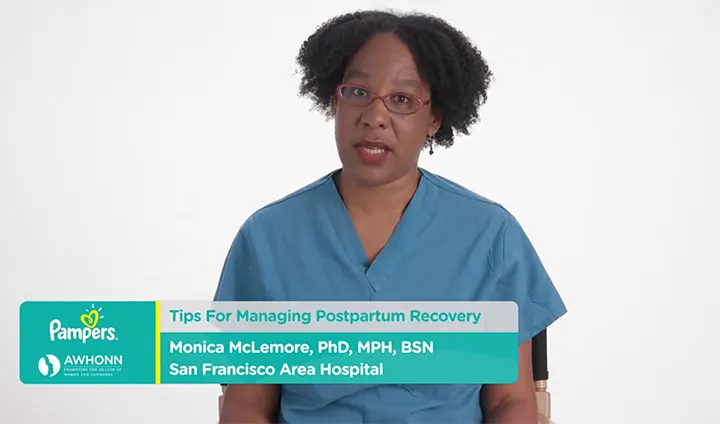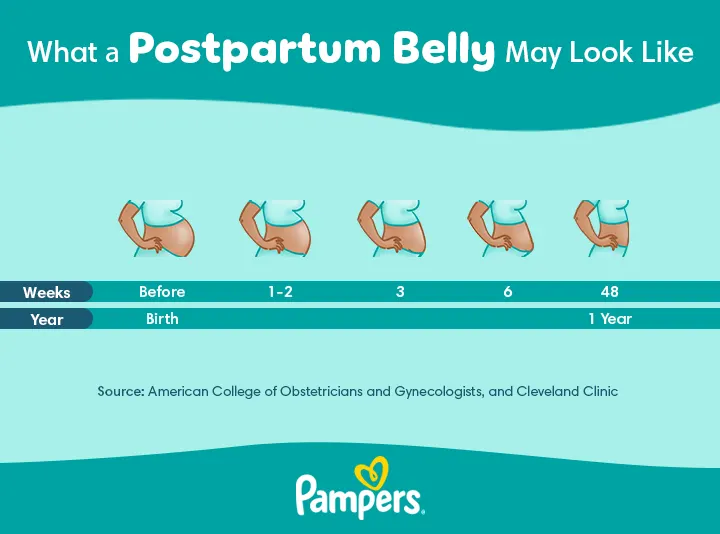Understanding Postpartum Belly Changes
It’s no secret that pregnancy brings many changes to your body. Your body is doing wonderful things as it helps your baby grow—and then you have the task of giving birth! Even once your little one arrives, you may still face physical changes post-pregnancy, especially with your postpartum belly. But it’s important to remember that a “real” postpartum belly, is your postpartum belly! Read on to discover how your body changes, how long your postpartum belly bump may last, and ways to support your recovery after birth to help empower you through your postpartum journey.
How Your Postpartum Belly Might Look and Feel After Pregnancy
After childbirth, you may be surprised to find that your stomach doesn’t immediately revert to its pre-pregnancy state. This is completely normal and expected. Initially, the abdomen may appear softer and rounder, similar to being pregnant in the early months. This look and feel are due to stretched muscles, loose skin, and residual bodily fluids that supported your baby during pregnancy.
If you had a cesarean birth, you will also have an abdominal incision on your belly. Your healthcare provider will give you advice on how to care for your cesarean-section incision and scar to help the healing process.
Some people may experience diastasis recti after pregnancy. This is when the muscles of the rectus abdominus separate during pregnancy and don’t go back to their normal positions. If your healthcare provider diagnoses you with diastasis recti, they’ll discuss your treatment options with you or refer you to a physical therapist.
So, if you think you still look and feel pregnant after giving birth, remember, in reality, this is normal and everyone’s postpartum stomachs will be different. Be patient and gentle with yourself as your body gradually returns to its pre-pregnancy shape.
Baby Development Milestones Taking care of your baby is one of the most important responsibilities as a parent. Track your little one's development with our articles! Learn more
How Long Does it Take for the Uterus to Shrink?
Postpartum, the uterus begins to contract and shrink back to its pre-pregnancy size shortly after delivery, a process called involution, which generally takes around six weeks. Every day, your uterus will gradually shrink and move downwards and back behind your bladder.
The uterus weighs about two pounds immediately after birth and is around seven inches long. Soon after delivery, it starts to decrease in size, and by about six weeks, it may reach close to its pre-pregnancy weight of two ounces and three inches in length.
During this period, you may feel your uterus contract and relax. These contractions, often felt as postpartum belly cramps or “afterbirth pains,” are a positive sign of healing and return to the pre-pregnancy uterine size.
Post-Pregnancy Belly Week by Week
The journey of the postpartum belly through the weeks and months after childbirth varies from person to person. While your uterus may shrink back to its postpartum size by around six weeks, it may take up to six months or longer for your body and belly to return to their pre-pregnancy state. Here’s a general idea of the postpartum belly progression week by week:
First Two Weeks Postpartum
Your stomach likely remains large and soft in the first couple of weeks after giving birth. Don’t be surprised if you still look pregnant. However, this postpartum period sees the most rapid reduction as the uterus contracts and gradually begins to shrink back to its pre-pregnancy size and weight. After one week, your uterus likely weighs half of what it did after delivery, and after two weeks it weighs around ten ounces.
3 Weeks Postpartum Belly
By 3 weeks after childbirth, your postpartum stomach may have undergone noticeable changes, yet it may still retain a more pronounced size compared to your pre-pregnancy state. Your abdominal muscles likely remain stretched, and the skin may still be loose, contributing to a softer belly. This is due to the gradual process of the muscles regaining their strength and elasticity.
Your uterus continues to contract during this period, significantly reducing in size and weight over the next few weeks as part of the involution process.
6 Weeks Postpartum Belly
Reaching the six-week mark after giving birth is often considered a milestone in a parent’s postpartum recovery journey. By this time, the uterus has typically returned to its pre-pregnancy size, but let’s be real, the appearance and feel of your postpartum body and belly at 6 weeks can vary widely among new parents.
The additional fluid retention and swelling that occurred during pregnancy and immediately postpartum has likely decreased, contributing to a reduction in your belly size. Your abdominal muscles may also start to regain more tone. However, for many, it’s common for muscles to still be pretty lax and weak, and the midsection might feel softer compared to pre-pregnancy.
Up to 1 Year Postpartum Stomach
A year into the postpartum period, you may notice a substantial difference in your body, including your stomach area, as you continue to recover from pregnancy and childbirth. Some people return to their pre-pregnancy weight, while others may find their body composition has permanently changed after giving birth.
With consistent exercise and a healthy, balanced diet, you may start to see improved muscle tone and skin elasticity in the abdominal area. However, it’s normal for the skin to retain some degree of looseness or for stretch marks to remain visible, as these are permanent changes for many.
The journey of regaining your pre-pregnancy body varies greatly from one parent to another, influenced by factors such as genetics, the nature of your delivery, diet, exercise, and overall lifestyle.
Exercises and Other Ways to Lose Your Postpartum Belly
Physical recovery and returning to your pre-pregnancy fitness levels is a gradual process that requires patience and self-care. Combining exercise and healthy eating can help you gradually regain your energy and get your body back to where you want it to be. Here are some tips for a “flat” tummy after pregnancy and effective ways to support the recovery of your postpartum belly:
Postpartum Belly Exercises
Before starting any postpartum exercise regimen, it’s recommended to wait until your healthcare provider gives you the green light. Once you get the go-ahead, try to stay active for 20 to 30 minutes per day, but remember to listen to your body and be gentle and patient with yourself.
Pelvic floor exercises. Kegels and other pelvic floor exercises strengthen the muscles weakened during pregnancy and childbirth. You can start by doing 3 sets of 10 contractions per day. Squeeze your pelvic floor muscles, as if you were stopping yourself from peeing, and hold this for 3 to 10 seconds (you can work your way up to 10 seconds over the weeks).
Core exercises. Because your core muscles (of your abdomen and lower back) were stretched during pregnancy as your uterus grew, exercises specific to your core can help strengthen and tone these muscles. A couple of these include:
Leg slides. Lie flat on your back with your knees slightly bent and feet flat on the floor. Engage your abdominal muscles, inhale, and slide one leg out straight. Exhale, and bring it back in. Repeat with the other leg.
4-point kneeling. Get in an all-fours position with your hips over your knees and your shoulders over your wrists. Keep your back straight and inhale deeply. Exhale and draw your belly button toward your spine (engaging your abdominal muscles). Repeat about five times.
Walking. This is a low-impact exercise that can be started relatively soon after birth and is a great way to ease yourself back into a fitness routine. Plus, getting out in the fresh air can also be beneficial to your mental health.
Swimming. Swimming is another low-impact exercise that works your whole body and doesn’t put any pressure on your joints.
Postpartum yoga. This helps in strengthening the core and improving flexibility, while also offering emotional calm. You might be able to find classes designed for new parents.
Postpartum Belly Nutrition
Healthy, balanced diet. Focusing on a balanced, nutrient-rich diet supports overall health, and postpartum healing, and can help with weight management. Just like throughout your pregnancy, try to eat plenty of fruits and vegetables, combined with whole grains and a variety of proteins. Reduce your intake of processed foods and those that are high in sugar and fat.
Hydration. Staying hydrated by drinking plenty of water is essential for recovery and aids in weight loss by promoting satiety and enhancing metabolism.
Postpartum Belly Wrap and Band
Belly wraps or bands are traditional postpartum aids embraced by various cultures to support the abdomen and uterus, offering both physical support and aiding recovery after childbirth. These wraps provide gentle compression to assist in reducing swelling, support weakened abdominal muscles and the uterus as it returns to its pre-pregnancy size, and can help improve posture during the recovery process.
While they can be beneficial in the initial weeks postpartum by making it easier to move around and engage in daily activities, it’s essential to use them correctly—snug but not too tight—and to consult with your healthcare provider before use, especially after a cesarean section. Belly wraps should be seen as a temporary support measure, complemented by a healthy diet and exercise for effective long-term postpartum recovery.
FAQS AT A GLANCE
The uterus usually takes around six weeks to return to its pre-pregnancy size through a process known as involution. This process may vary slightly from person to person and can be influenced by factors such as breastfeeding.
The Bottom Line
The postpartum period is a time of significant physical and emotional adjustment. Understanding the changes your body undergoes and knowing that recovery takes time can help you set realistic expectations and be compassionate with yourself. Remember, everyone’s experience (and post-pregnancy belly) is unique, and embracing your body’s pace of recovery is a vital step toward wellness and strength.
If you haven’t already, download our Pampers Club app to get rewards and discounts on all those diapers your little one is going through.
How We Wrote This Article The information in this article is based on expert advice found in trusted medical and government sources, such as the American Academy of Pediatrics and the American College of Obstetricians and Gynecologists. You can find a full list of sources used for this article below. The content on this page should not replace professional medical advice. Always consult medical professionals for full diagnosis and treatment.
Join Pampers Club and get:





